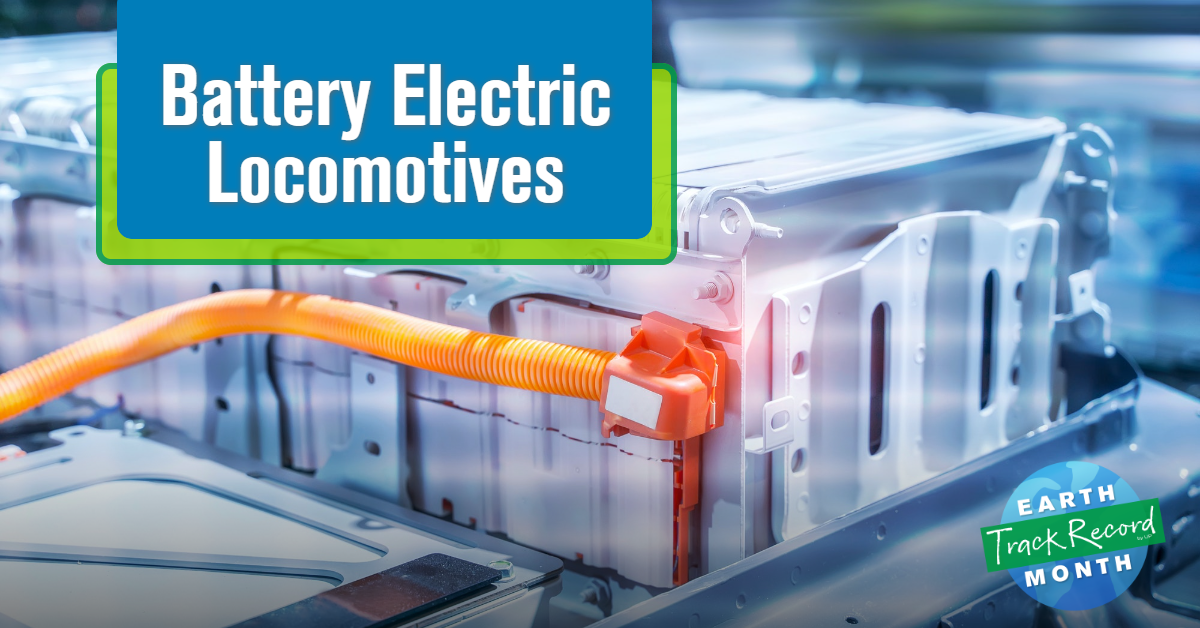Moving freight by rail instead of truck lowers greenhouse gas (GHG) emissions by up to 75%, on average. Trains are already an environmentally responsible shipping choice, and railroads continue to take steps to reduce the impact of freight shipping on climate change.
One method railroads employ involves using technology to make their locomotives more fuel efficient, which in turn reduces GHG emissions. Now, battery-electric locomotives are poised to be an additional technology to help the railroad industry take a big leap toward running net-zero emission operations.
How Are Battery-Electric Locomotives Being Used?
Battery-electric locomotives are still in their infancy for the freight rail industry. But over the coming years, that’s likely to change.
Union Pacific Railroad recently announced plans to purchase 20 battery-electric locomotives for testing in yard operations. The locomotives will be acquired from two companies at the forefront of locomotive innovation: Progress Rail, a Caterpillar company, and Wabtec Corporation.
Between the sticker price of the locomotives and the cost of the necessary upgrades to yard infrastructure, the investment is expected to exceed $100 million — the largest investment in battery-electric technology by a North American railroad. This will also make Union Pacific the operator of the world’s largest carrier-owned battery-electric locomotive fleet in freight service. This investment is supported in part by the Port of Los Angeles, which recently received a Diesel Emission Reduction Act (DERA) grant from the U.S. Environmental Protection Agency and awarded Union Pacific a subaward that will partially cover the cost of one battery-electric locomotive.
The new battery-electric locomotives will be used for rail yard operations, but Union Pacific plans to work with locomotive manufacturers during this test phase to evaluate the potential of using battery-electric locomotives for long-haul shipments.
In order to test the locomotives for performance in both warm and cold weather, the locomotives will be used in rail yards in California and Nebraska. These tests will help determine if battery-electric technology is viable for a larger roll out. The first units are scheduled to arrive in late 2023; all 20 should be in place the following year.
The hope is that the first phase of testing these units will help the technology continue to evolve in a way that benefits the entire railroad industry.
What Are the Environmental Benefits of Battery-Electric Locomotives?
Because electric engines don’t use fuel, they also don’t emit greenhouse gases and other criteria pollutants. How does that stack up against diesel-powered locomotives? Union Pacific’s 20-locomotive test could reduce emissions by an estimated 8,000 tons of carbon annually, similar to removing 1,600 cars from U.S. roadways.
Battery-powered locomotives are also much quieter than their diesel counterparts, reducing noise by up to 70%.
Between a reduction in noise pollution and air pollution, communities adjacent to rail operations also stand to benefit.
The Next Step in the Net-Zero Journey
While adopting battery-electric locomotives is an important step forward for reducing freight rail emissions, it’s only one step in the railroad industry’s environmental journey.
Union Pacific’s Climate Action Plan lays out a goal of achieving its science-based target with a longer-term view toward net-zero emissions by 2050. This starts with reducing our absolute Scope 1 and 2 greenhouse gas emissions 26% by the end of this decade. In addition to leveraging battery-electric locomotives, the plan also includes continuing to make our operations more efficient through a better service plan, implementing technology that helps us reduce the amount of fuel we burn, and expanding use of low-carbon fuels like biodiesel and renewable diesel.
Of course, no single railroad can address climate change alone; meaningful action will require the collective efforts of the entire rail industry as well as action on the parts of the industries railroads serve to reduce the transportation sector’s share of GHG emissions.
Your Shipments Can Play a Part in Addressing Climate Change
If your company ships products by truck, shipping by rail instead is one way to play an important role in reducing greenhouse gas emissions and addressing climate change.
Because trains are 3 to 4 times more fuel efficient than trucks, moving freight by rail instead of truck reduces greenhouse gas emissions by up to 75%. That means the transportation mode you choose is an important one for the planet.
In fact, if 25% of the truck traffic moving at least 750 miles traveled by rail instead, annual greenhouse gas emissions would fall by approximately 13.1 million tons; if 50% of the truck traffic moving at least 750 miles went by rail instead, greenhouse gas emissions would fall by approximately 26.2 million tons.
Learn More
If you’d like to learn more about shipping by rail and reducing your company’s environmental impact, answer a few questions and an expert will be in touch.
Related Articles
- Freight Shipping and Its Impact on Climate Change
- How Are Locomotives Getting More Fuel Efficient for the Railroad Industry?
- What Can You Ship by Rail?
- The Top Railroad Terms and Their Definitions: Beginner’s Edition
- Intermodal vs. Transloading
- Transloading Decoded
- Quiz: Is Rail the Right Fit for Your Shipments?
- Rail 101 FAQs









